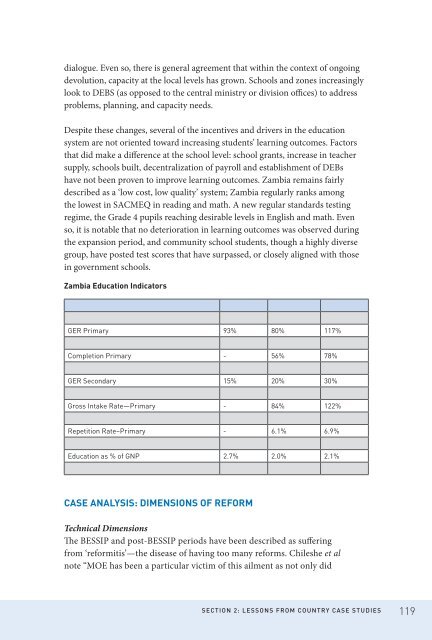The Power of Persistence: Education System ... - EQUIP123.net
The Power of Persistence: Education System ... - EQUIP123.net
The Power of Persistence: Education System ... - EQUIP123.net
You also want an ePaper? Increase the reach of your titles
YUMPU automatically turns print PDFs into web optimized ePapers that Google loves.
dialogue. Even so, there is general agreement that within the context <strong>of</strong> ongoing<br />
devolution, capacity at the local levels has grown. Schools and zones increasingly<br />
look to DEBS (as opposed to the central ministry or division <strong>of</strong>fices) to address<br />
problems, planning, and capacity needs.<br />
Despite these changes, several <strong>of</strong> the incentives and drivers in the education<br />
system are not oriented toward increasing students’ learning outcomes. Factors<br />
that did make a difference at the school level: school grants, increase in teacher<br />
supply, schools built, decentralization <strong>of</strong> payroll and establishment <strong>of</strong> DEBs<br />
have not been proven to improve learning outcomes. Zambia remains fairly<br />
described as a ‘low cost, low quality’ system; Zambia regularly ranks among<br />
the lowest in SACMEQ in reading and math. A new regular standards testing<br />
regime, the Grade 4 pupils reaching desirable levels in English and math. Even<br />
so, it is notable that no deterioration in learning outcomes was observed during<br />
the expansion period, and community school students, though a highly diverse<br />
group, have posted test scores that have surpassed, or closely aligned with those<br />
in government schools.<br />
Zambia <strong>Education</strong> Indicators<br />
Indicator 1991 1999/2000 2006<br />
Number <strong>of</strong> Primary Students 1,510,000 2,460,000 2,446,000<br />
GER Primary 93% 80% 117%<br />
NER Primary 78% 68% 92%<br />
Completion Primary - 56% 78%<br />
Survival to Grade 5 - 81% 89%<br />
GER Secondary 15% 20% 30%<br />
teacher Pupil Ratio - 47:1 51:1<br />
Gross Intake Rate—Primary - 84% 122%<br />
Gender Equity Ratio (Girls:boys)—Primary - .92 .98<br />
Repetition Rate–Primary - 6.1% 6.9%<br />
<strong>Education</strong> as % <strong>of</strong> Government budget 7.1% - 15%<br />
<strong>Education</strong> as % <strong>of</strong> GNP 2.7% 2.0% 2.1%<br />
$ Per Pupil $55<br />
CASE ANALySIS: DIMENSIONS OF REFORM<br />
Technical Dimensions<br />
<strong>The</strong> BESSIP and post-BESSIP periods have been described as suffering<br />
from ‘reformitis’—the disease <strong>of</strong> having too many reforms. Chileshe et al<br />
note “MOE has been a particular victim <strong>of</strong> this ailment as not only did<br />
SECTION 2: lESSONS fROM COUNTRY CASE STUdIES<br />
119

















